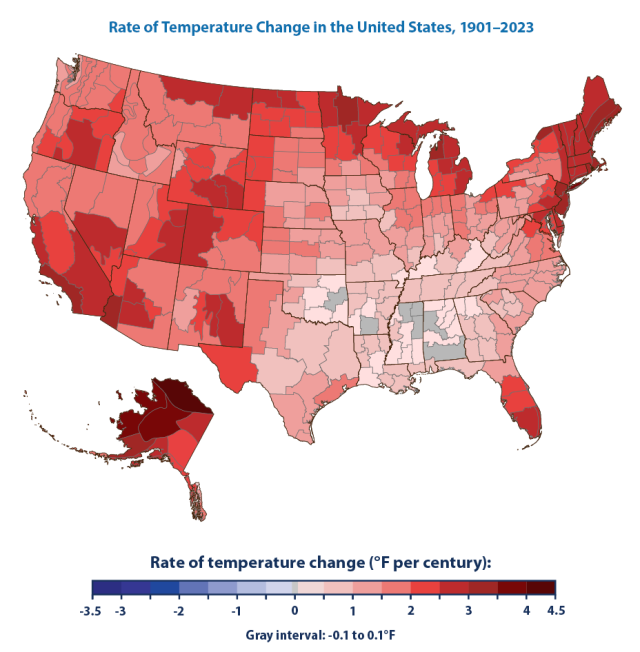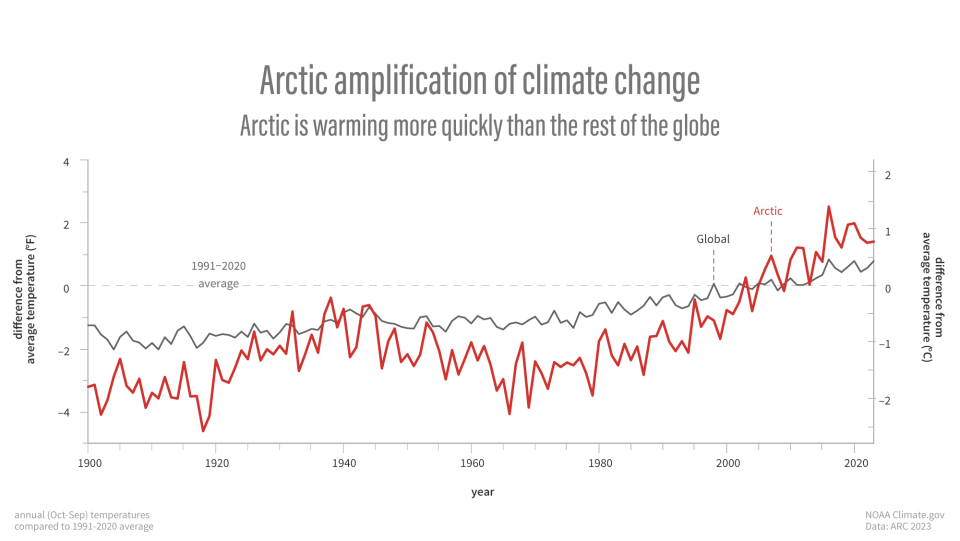Drivers of Climate Change in the Arctic
Warming has led to many observed changes in the Arctic environment and impacts on communities. This page gives an overview of the science of climate change in the Arctic and Alaska, highlighting why the Arctic is warming faster than other regions.
Explore the sections on this page to learn more about:
Rapid Warming in the Arctic

Average global temperatures are rising and the Earth's climate is changing. Most of the warming since 1950 has been caused by human emissions of greenhouse gases. These greenhouse gases come from a variety of human activities like burning fossil fuels for heat and energy, clearing forests, fertilizing crops, storing waste in landfills, raising livestock, and producing industrial goods. Learn more about the causes of climate change.
While average temperatures at the Earth's surface are expected to keep rising, places in the Arctic and Alaska are warming at an even faster rate. Global average temperature has increased about 1.7 degrees Fahrenheit (°F) since 1970. During the same period, temperatures have risen around 2.5°F in the contiguous United States and 4.2°F in Alaska.1 The EPA’s U.S. and Global Temperature Indicator shows that Alaska has warmed faster than the global average and more than any other U.S. state over the past century. Regionally, Alaska’s North Slope (above 69°N) has warmed at the fastest rate.2
In the Arctic, many ecosystem features, like sea ice and permafrost, rely on freezing temperatures (below 32°F). Warming average temperatures can create tipping points. A tipping point is a threshold that, when crossed, leads to large, accelerating, and often irreversible changes in the climate system.
Causes of Arctic Amplification
“Arctic amplification” describes the observed amplification or increased rate of global warming in Arctic regions relative to the global average. This rapid warming is caused by multiple factors, including physical changes at the poles.

Melting Sea Ice and Snow Cover Loss
One factor leading to Arctic amplification is the increased loss of Arctic sea ice and land snow cover. Sea ice is sea water that freezes on the ocean surface and can expand down to several feet below the surface. During the dark winter months, sea ice essentially covers the entire Arctic Ocean. In summer, much of the sea ice melts due to warmer temperatures and long hours of sunlight. Arctic sea ice typically reaches its minimum thickness and extent in mid-September, when the area covered by ice is roughly half the size of the winter maximum.4 The extent of area covered by Arctic sea ice is an important indicator of changes in global climate because warmer air and water temperatures are reducing the thickness and extent of sea ice. Sea ice increases the surface albedo in the Arctic, or the amount of solar radiation reflected by the Earth's surface. Sea ice also keeps the air cool by forming a barrier between the cold air above and the relatively warmer water below.5 As the amount of light-colored sea ice decreases and darker-colored open ocean is exposed, the surface reflectivity, or albedo, in the Arctic decreases. This reduces the Arctic region’s cooling effect and causes the Arctic Ocean to warm from more absorption of solar energy.
Similarly, snow cover loss on land at high latitudes can lead to more warming as the snow retreat exposes darker ground, which will absorb more sunlight. Because snow is white, it absorbs only a small portion of the sunlight that hits it and reflects the rest back to space. In contrast, darker surfaces such as bare ground absorb more energy and heat up more quickly. The overall amount of snow cover affects patterns of heating and cooling over the Earth's surface. Less snow cover means the Earth's surface absorbs more energy, resulting in warming.
Other Factors in Arctic Amplification
While a primary factor for Arctic amplification is the reduction of the albedo effect due to decreasing snow and ice cover, other factors can amplify warming at high latitudes compared to other regions,8 including:
- Planck Feedback: Energy warms cold objects more than warm ones. In the same way, the energy trapped by greenhouse gases will cause more warming in the cold Arctic than in the warm tropics.9
- Lapse Rate Feedback: In the Arctic, most of the heating occurs at ground level, not throughout the atmosphere. The lapse rate describes the rate at which temperatures in the atmosphere change with altitude. 10 As a result of this vertical structure, warming in many non-Arctic regions results in more heat at higher altitudes, which results in increases in the amount of heat lost to space. In contrast, due to a difference in the vertical temperature structure in the Arctic, increased warming leads to more heating occurring at ground level, which does not increase the amount of heat lost to space as much as in other regions, leading to warming amplification.
- Atmospheric Heat Transport: A larger increase in moisture in the tropics increases the rate of heat transport from the tropics to the Arctic.11
Global climate change is leading to many other complex effects on the Arctic climate, like changes in heat and water transport to the Arctic and changes in Arctic cloud cover. The mechanisms and net effects of these and other changes continues to be an active area of research to understand their net impact on Arctic warming.
References
1 Marvel, K., W. Su, R. Delgado, S. Aarons, A. Chatterjee, M.E. Garcia, Z. Hausfather, K. Hayhoe, D.A. Hence, E.B. Jewett, A. Robel, D. Singh, A. Tripati, and R.S. Vose. (2023). Ch. 2. Climate trends. In: Fifth National Climate Assessment. Crimmins, A.R., C.W. Avery, D.R. Easterling, K.E. Kunkel, B.C. Stewart, and T.K. Maycock, Eds. U.S. Global Change Research Program, Washington, DC, USA., p. 2-11.
2 Huntington, H.P., C. Strawhacker, J. Falke, E.M. Ward, L. Behnken, T.N. Curry, A.C. Herrmann, C.U. Itchuaqiyaq, J.S. Littell, E.A. Logerwell, D. Meeker, J.R. Overbeck, D.L. Peter, R. Pincus, A.A. Quintyne, S.F. Trainor, and S.A. Yoder. (2023). Ch. 29. Alaska. In: Fifth National Climate Assessment. Crimmins, A.R., C.W. Avery, D.R. Easterling, K.E. Kunkel, B.C. Stewart, and T.K. Maycock, Eds. U.S. Global Change Research Program, Washington, DC, USA., p. 29-6.
3 Lindsey, R., Frost, M.S., and Macander, M. (2023). 2023 Arctic Report Card: Image Highlights. National Oceanographic and Atmospheric Administration (NOAA). https://www.climate.gov/news-features/understanding-climate/2023-arctic-report-card-image-highlights
4 EPA. (2024). Climate Change Indicators: Arctic Sea Ice. Accessed December 20 2024, https://www.epa.gov/climate-indicators/climate-change-indicators-arctic-sea-ice
5 EPA. (2024). Climate Change Indicators: Arctic Sea Ice. Accessed December 20 2024, https://www.epa.gov/climate-indicators/climate-change-indicators-arctic-sea-ice
6 Arctic Monitoring and Assessment Programme (AMAP). (2021). Arctic Climate Change Update 2021: Key Trends and Impacts. Summary for Policy-Makers. AMAP. https://www.amap.no/documents/doc/arctic-climate-change-update-2021-key-trends-and-impacts.-summary-for-policy-makers/3508, p. 5.
7 Arctic Monitoring and Assessment Programme (AMAP). (2021). Arctic Climate Change Update 2021: Key Trends and Impacts. Summary for Policy-Makers. AMAP. https://www.amap.no/documents/doc/arctic-climate-change-update-2021-key-trends-and-impacts.-summary-for-policy-makers/3508, p. 5.
8 Lindsey, R., M. S. Frost, and M. Macander. (2023). 2023 Arctic Report Card: Image Highlights. National Oceanographic and Atmospheric Administration (NOAA). https://www.climate.gov/news-features/understanding-climate/2023-arctic-report-card-image-highlights
9 Previdi, M., K. L. Smith, and L. M. Polvani. (2021). Arctic amplification of climate change: a review of underlying mechanisms. Environmental Research Letters 16, 093003. https://doi.org/10.1088/1748-9326/ac1c29
10 Previdi, M., T. P. Janoski, G. Chiodo, et al. (2020). Arctic amplification: A rapid response to radiative forcing. Geophysical Research Letters 47, no. 17. https://doi.org/10.1029/2020GL089933
11 Taylor, P.C., R. C. Boeke, L. N. Boisvert, et al. (2022). Process drivers, inter-model spread, and the path forward: A review of amplified arctic warming. Frontiers in Earth Science 9, 758361. https://doi.org/10.3389/feart.2021.758361
